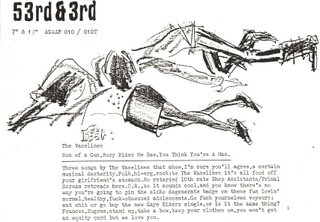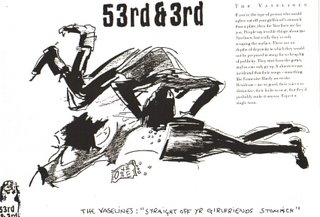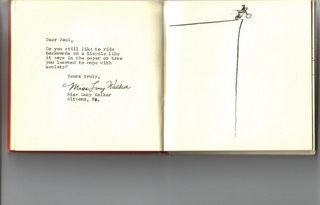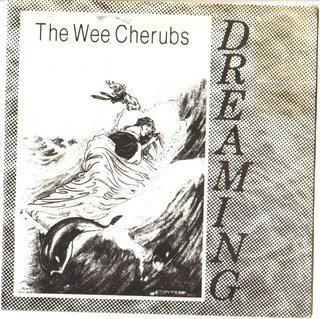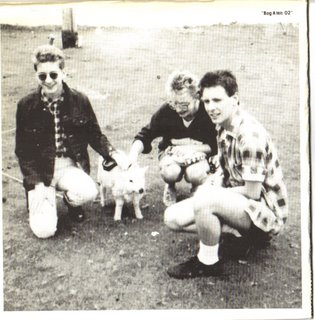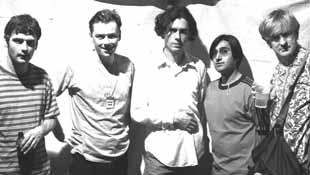
BMX Bandits: Proudly hippy-bashing for twenty years
The hotchpotch snapshot of the contemporary British guitar scene, a cassette called “C-86”, was issued twenty years ago by the NME. What no one involved in the compilation could have realised at the time was that two decades later C86 would not only be shorthand for a certain type of music represented by 12 of the compilation’s 22 acts, but more importantly that certain type of music would be the most popular form of underground indie in the world.
The continued popularity of C86 echoes soul aficionado Tony Cummings’ observation in his Afterword to his essay, Playing Records:
“Back in 1973 I was able to document the birth of Northern Soul. What I never for one moment imagined was that twenty years on the Northern Soul cultural phenomenon would still be with us…Maybe Northern Soul will never again spill into the pop overground, but it refuses to die.” [1]
The music on the C-86 compilation that is now a synonym for indiepop or, often more derogatively, twee, was provided by bands like The Pastels, The Shop Assistants and Mighty Mighty. The scene’s influences were most obviously the Velvet Underground’s Loaded, The Byrds’ sunny jangle, Buzzcocks’ punk-pop, Jonathan Richman’s faux-naivety, Television Personalities’ childlike approach and Orange Juice’s wry adaptation of all of the above.
C86’s failure to make a bigger impact twenty years ago was partly a matter of timing. It was in the middle of a decade where success was measured in conspicuous consumption, tawdry expenditure and general excess. C86’s refusal to accept any of the dominant consumerist trappings of the age made it an outsider movement that could never transfer its DIY ideals into the age’s economic climate.
1986 also marked the last year before indie’s overtly guitar-based scions were swept away by the hedonistic values of a new form of dance music. The ‘hip hop wars’ that then occupied the NME, where the old guard resolutely battled for the monopoly of indie music against the swell of support for the politicised, energetic force of hip hop, were laid to waste in the following two years as it became apparent that the nation’s youth didn’t much care for either guitars or rapping; what they really wanted to do was take drugs and dance all night.
Glossy magazines with an emphasis on style and music as a consequence, rather than the subject, of that style became required reading for these music fans – if they read anything at all. The NME looked over its shoulder, took a quick glance at the last scene they had championed - C86 - and cringed with embarrassment. Just maybe, their championing of girly dickweed pop music had driven a generation into the clutches of pulsating Roland TR-808 synths and mind-bending rave drug ecstasy, thus destroying their publication’s credibility!
The ilk of Razorcuts, Close Lobsters and Talulah Gosh sounded to them, then, like the death knell for indie music. They had been fooled! In the words of one such style magazine, i-D, the C86 scene was:
“Childlike innocence and assumed naivety permeate the Cutie scene – their clothes are asexual, their haircuts are fringes, their colours are pastel. Cuties like Penguin modern classics, sweets, ginger beer, vegetables and anoraks. Heroes include Christopher Robin…Buzzcocks and The Undertones.” [2]
The male-dominated music press was emasculated. They would never again champion such effete music, but they couldn’t champion house music – not only was it something to dance to, not read earnest critiques of, they didn’t have the first clue about it. They could only just manage writing about New Order. The trad press only recovered its bearings a couple of years later when Manchester’s pioneers navigated the path between (60s) guitars and (modern) dance.
Anything that smacked of C86 – stripy t-shirts, bowl haircuts and tomboyish female singers (so it was ok to like The Primitives) – was ridiculed for being “fey”, “twee” and, the ultimate insult, “limp-wristed”. C86 exposed both the homophobia of the mainstream music press and its hidebound adherence to rock. It continues to do so today.
What is never considered by such rockists is the inherently political nature of C86. The deliberate return to the state of innocence by C86 bands was a revolt against the traditional rock mentality. Calling your band BMX Bandits or releasing a single called My Best Friend was to stick two fingers up at rock orthodoxy. The asexual appearance of, for example, Talulah Gosh’s two female members was to negate the received opinion of women in pop as sex objects far more powerfully than Helen Reddy singing I Am Woman or Gloria Gaynor singing I Will Survive. C86 produced women who not only didn’t believe in rock’s gender hierarchy, they didn’t need it.
As for the men, those men who were ridiculed as limp-wristed by journalists who would later applaud Bert Anderson’s hackneyed androgyny and pretence of bisexuality as bravely being ‘in touch with his feminine side’, rather than being in touch with his Bowie records and record company’s marketing department, deliberately ignored fashion trends and, particularly, the tired uber-masculinity of rock’s leather and lysergic orthodoxy. The anoraks that they were so derided for were, along with a staple of charity shop shirts and jeans, part of a deliberately utilitarian, unisex approach to image. The point was that anyone could join in, everyone was welcome. The inclusiveness that punk itself claimed was undercut by its strict adherence to fashion and the cultivation of a mob ethic among fans, especially gig audiences, to reflect the vitriol in the music. C86 was the first post-punk subculture to which access was free, image unimportant and all were welcome.
This ideal had first been attempted in the immediate post-punk period, gloriously by Orange Juice whose Consolation Prize contains the immortal lines:
“I wore my fringe like Roger McGuinn's
I was hoping to impress
So frightfully camp, it made you laugh
Tomorrow I'll buy myself a dress”;
and by one of the age’s true mavericks, Vic Godard. As erstwhile Orange Juice manager and Postcard records supremo Alan Horne put it: “…for a male group like Subway Sect the idea was to work not with power, but with weakness and introversion.”
C86 was the most punk of all the post-punk movements; it had what rock critic Simon Reynolds described in 1986 as “a hatred of anything hippy (long tracks, virtuosity, complex instrumentation, mysticism, pomp, fusion)." [3] Its DIY focus allowed an open-door policy to join the club whether as a band or a fan.
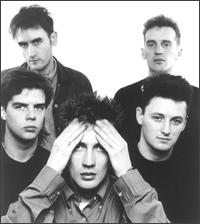
The Close Lobsters sense relief after sacking their fashion stylist
The way in which the music was consumed also reflected punk’s concerns. C86 meant 7” singles, cheap flexidiscs, low production values, accessible gigs and a thriving samizdat; the antithesis to the cultural orthodoxy of stadium tours, 12” singles, the grey revival of superannuated stars post-Live Aid, 72-track studios and glossy lifestyle magazines. Formatting had become one of the burning issues of the C86 period, with fanzines, led by Are You Scared To Get Happy, insisting with an evangelical zeal upon 7” singles.
Disregarding aesthetics, the central argument for 7” singles was economic. They were half the price of 12” singles, so a fan could buy twice as many records if they were on 7” rather than 12”. The central argument for indie labels was also economic. They were far less likely to lose money and might break even if they issued singles on 12”. There is usually no money to be made on mechanical royalties no matter how many singles, 7” or 12” are sold, as Alan McGee noted when he just broke even on Velocity Girl, having sold several thousand copies, mostly on 12”.
When in 1987 the major labels got their mitts on bands such as The Bodines and The Shop Assistants, they had about as much idea marketing them as they did the hip hop acts they were also trying to make a fast buck out of. They released indiepop on 12” and hip hop on 7”, a tragic misreading of their audiences. Lest we forget, though, the major labels pretended they weren’t actually releasing indiepop. Because it was heresy for an indie band to be on a major, the majors created subsidiaries, such as Chrysalis’ Blue Guitar, where indiepop would be given the gloss of authenticity. They would also be banished from the indie charts and have a cat in hell’s chance of breaking the top 40.
When the majors’ interest had cooled, the public’s had already waned and by the end of 1987 Sarah Records had launched, signposting the ghettoising of indiepop. Sarah, run by Matt Haynes of Are You Scared To Get Happy fanzine and Clare Wadd of Kvatch fanzine, understood their position from the start. They knew that indiepop was a target for the rock press so they were deliberately provocative – giving the label a girl’s name was a reaction against rock’s male hegemony – and suffered opprobrium and bile for their efforts. All their bands were, naturally, “limp-wristed”.
Sarah, with a catalogue formed largely by 7” eps with some flexidiscs and fanzines, and an emphasis on jangly guitars, represented the most public continuation of the C86 traditions. By now, C86 had come to mean something that the tape’s compilers hadn’t intended and to which all the bands compiled were oblivious, precisely because it wasn’t an adjective in 1986.
By accident rather than design, that tape had included 12 acts who played melodic indie, dreamt of being The Beatles in 1963 but knew they had bugger all chance of realising that dream but why not have fun trying. All 22 of the bands, however, operated in a communal, co-operative manner, along with dozens of forgotten bands from that era; most music fans didn’t delineate between indiepop and the off-kilter Fall/Beefheart jerkiness of Stump, A Witness and The MacKenzies.
The spirit in which those bands operated, moreover, was the essence of indie and it’s those ideals that Sarah aimed to continue and have been exported around the world. There would have been, for example, no Sub Pop Singles Club without C86, no network of people to sell the singles to and no open culture of promoting gigs, records and new bands without C86. There certainly wouldn’t have been riot grrrl without the feminisation of music that C86, far more so than punk, engendered. Even punk’s women sexualised themselves – The Slits, anyone? – in that brash ethic of the late 1970s.
As we know, C86 as a musical term has since come to mean jangly, possibly effeminate, no fuss-and-bother pop and it is with that description as a weapon that the subsequent scene has come to be beaten. Of course, there are bands who live up to the stereotype, but then there are always those on both sides of the fence who don’t quite understand. Or, as Julius Caesar commented in The Ides of March, “In the end, it is impossible not to become what others believe you are.”
In the USA, Sweden and Japan, where C86 is most popular, however, it is that vulnerable essence that has come to be celebrated. Perhaps unsurprisingly in Japan, a centre for cuteness; in Sweden and the USA, homes to traditional rock and metal, it remains a music of subversion.
Often a very popular form of subversion, if we consider the success of bands like Sweden’s Cardigans and America’s The Shins – respectively beloved of Hollywood film soundtracks and corporate advertisers. C86 has gone mainstream while – as ever – remaining underground.
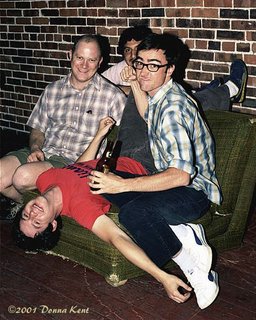
The Shins: "would you poor British guys like some of our money?"
It remained underground in Britain until the emergence of Belle and Sebastian in 1996. “Nobody else writes them like they used to, so it may as well be me,” Stuart Murdoch opined on Get Me Away From Here, I’m Dying, from 96’s If You’re Feeling Sinister. With two brilliant albums in the space of six months during the suffocating bluster of Britpop’s macho swagger and rock posturing, Belle and Sebastian’s grand, swooning romances, a confident mastery of 60s pop hooks and a copybook indebted to the two masters of bold songs and effeminate undertones, Edwyn Collins and Pete Shelley, Belle and Sebastian were the catalyst for a mass return to C86, a music that needed only a transcendent figurehead among its number, not a resuscitation, to impose a sense of order upon the scene.
The official line if you read the rock press, of course, is merely that Belle and Sebastian are a band for ex-Smiths fans. This official line is deeply problematic. To this hardcore they are alluding there really is no such thing as an ex-Smiths fan: they are Smiths fans for life. To the masses that loved The Smiths, they’d either found new bands in the intervening nine years or just lost interest in music, as is the problem with so many who grow up and forget what helped them get to be a grown up. To pinpoint The Smiths rather than any old indie band with a devoted following is simply to ally Belle and Sebastian with Morrissey’s homosexuality and the caricatures of the effete indie.
What this official line misses is what it has always missed: C86 didn’t go away, Belle and Sebastian are a product of that music and the fanbase was already there for them; the thousands of other fans they attracted were not put off by the rock press’s tired diktats and put-downs because to a younger audience those slurs are no longer relevant. Indeed, embracing music and style outside of rock’s conforms is something to celebrate, not denigrate, and the new subcultural adoption of C86’s original ideals has never been more attractive.
Unlike that other indefatigable cult, Northern Soul, C86 has spilled over into the pop overground; in tandem with Northern Soul, it is also now a part of the record collecting market commanding seriously silly price tags. That air of rarity around older elements of the scene, together with the more obvious, public face of the scene, helps attract fans who seek non-mainstream records with a specialist provenance. This attraction is another facet of the past decade’s consumer movement for the boutique in the barrage of homogenised, globalised product.
A touching aspect of C86’s resurgence is the occasional band from twenty years ago reforming and playing not just to a handful of old mates and prurient co-workers from their proper jobs, but mainly to hordes of enthusiastic, starry-eyed punters too young (not even born in some cases) to have either heard of them or had the chance to see them originally. What these situations have reinforced is that all are welcome. No one is made to feel out of place and no one’s dress sense is sneered at precisely because there isn’t a dress code to adhere to. Try finding that inclusiveness at the gigs of any other reformed ‘scene’ bands.
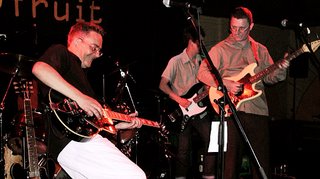
The June Brides: old enough to be the fathers of their new fans (and in the cases of the uglier ones, probably are)
One of the more interesting effects of C86’s post-96 kickstart is the number of nightclubs that have sprung up to cater for these fans. In London, the Track and Field label started life as a club in 1999, following Belle and Sebastian’s Bowlie festival of that year. As attendees will remember, if they can remember anything from that weekend, is that alcohol and socialising were the important factors at Bowlie. The stereotype of these fans as sexless wallflowers was blown out of the water by behaviour that suggested that libraries and sweetie shops were less appropriate hideouts than AA and the clap clinic.
Club nights supporting indiepop thrive in, for example, London, proving a catalyst for new bands to form, gigs to be promoted, record labels to be founded and websites to be launched. At the time of writing, the most popular club night is How Does It Feel To Be Loved. Perhaps ironically, this fortnightly club is run by a man who despite being of an age to remember 1986’s indie underground, is almost clueless about indiepop before Belle and Sebastian. The club is essentially a Belle and Sebastian fan’s interest and as such does what many similar clubs fail to do: plays new music that its punters suggest and are excited about. Because there are great new bands coming through and there have been great records released this year – just like last year and, without doubt, next year too.
It has ever been thus. In twenty years’ time, I expect to see you and very probably your teenage children and their mates at Voxtrot’s reunion. But then, the musical climate is right for them to get their dues and in 2026 they’ll probably be retired in luxury, talking to each other only through their lawyers. They’ll have a lot of forgotten bands, fanzine writers and gig promoters from mid-80s Britain to thank for their success.
[1] The Beat Goes On, p62-3, ed Charlie Gillett and Simon Frith, Pluto Press, 1996 (London)
[2] Quoted in The End-of-the-Century Party, Youth and Pop Towards 2000 by Steve Redhead, p82, Manchester University Press, 1990 (Manchester)
[3] Quoted in Steve Redhead, ibid, p81

